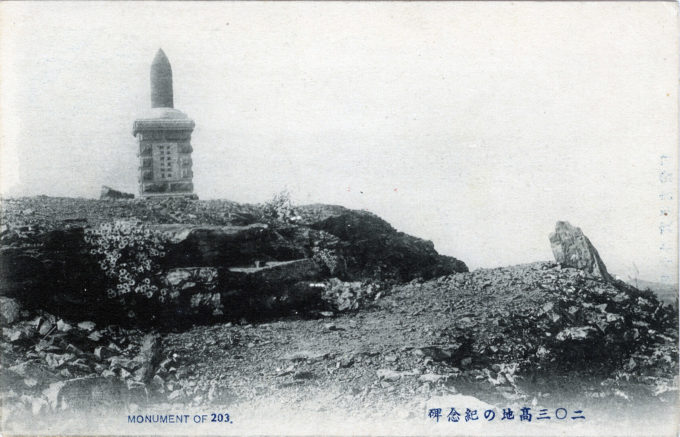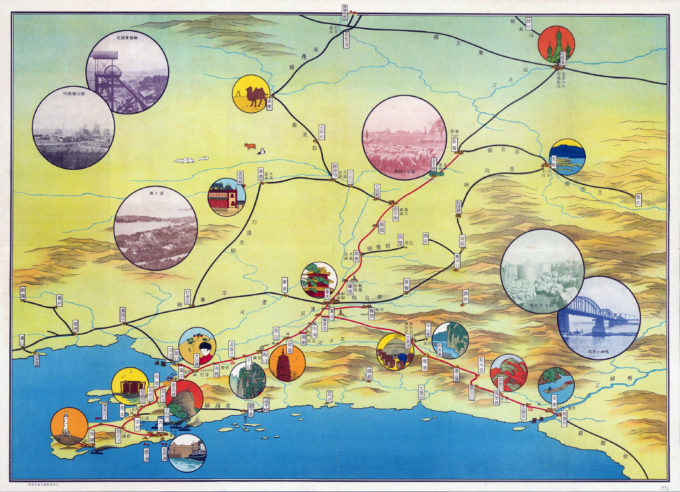Can we say it was easy to climb 203 Hill?
Was it not difficult because men sought their honor?
The mountain has changed its shape, covered by iron and blood.
We all now equally look up in awe at the mountain where your souls lie.
– General Nogi Maresuke
from his kanshi poem “Mountain Where Your Souls Lie” (1905)
See also:
Count (General) Nogi Maresuke.
The Funeral of Commander Hirose, Tokyo, 1904.
“The siege of Port Arthur (August 1, 1904–January 2, 1905) was the longest and most violent land battle of the Russo-Japanese War.
“The siege of Port Arthur saw the introduction of much technology used in subsequent wars of the 20th century (particularly in World War I) including massive 28 cm Howitzers capable of hurling 217-kilogram (478-pound) shells over 8 kilometers (5.0 miles), as well as Maxim machine guns, barbed wire entanglements, electric fences, searchlights, tactical radio signalling (and, in response, the first military use of radio jamming), and hand grenades. One other innovation of the campaign was the centralization of the Japanese fire control, with the artillery batteries connected to the field headquarters by miles of telephone lines.
“The highest elevation within Port Arthur, designated ‘203-Meter Hill’, overlooked the harbor … It was initially unfortified; however, after the start of the war the Russians realized its critical importance and built a strong defensive position. In addition to natural ramparts with steep sides, Hill 203 was protected by a massive redoubt and two earth-covered keeps reinforced by steel rails and timber, and was completely surrounded by electrified barbed wire entanglements.
“… Battles for the hill continued throughout October into November, with some very heavy hand-to-hand combat for control of the summit changing hands several times. Finally, after almost four months of fighting, at 10:30 a.m. on December 5 the Japanese managed to overrun 203 Meter Hill. The Russians launched two counter-attacks to retake the hill, both of which failed, and by the evening, 203 Meter Hill was securely under Japanese control.
“Now, with a spotter on a telephone line at the vantage point on 203 Meter Hill overlooking Port Arthur harbor, Nogi could now bombard the Russian fleet with Howitzers firing armor-piercing shells, beginning to systematically sink the Russian ships within range. Five battleships and two cruisers of the Russian Pacifc Fleet were sunk in this fashion.
Map: 1940 Port Arthur & Manchuria. The monument atop Hill 203, and its site relative to Port Arthur harbor, can be seen circled (in orange) at the far lower-left.
“Stung by the fact that the Russian Pacific Fleet had been sunk by the Imperial Japanese Army and not by the Imperial Japanese Navy, and with a direct order from Tokyo that the sole-remaining Russian battleship, Sevastopol, was not to be allowed to escape, Admiral Togo sent in wave after wave of destroyers in six separate attacks. After 3 weeks, the Sevastopol was still afloat, having survived 124 torpedoes fired at her while Togo lost two destroyers with damage to six other IJN vessels.
“For Japan, the cost of capturing this landmark was great, with over 8,000 dead and wounded in the final assault alone, including most of the IJA 7th Division. For Nogi, the cost of capturing 203 Meter Hill was made even more poignant when he received word that his last surviving son had been killed in action during the final assault on the hill.”
– Wikipedia




Pingback: “The peace envoys of Japan and Russia at Portsmouth (N.H.) Navy Yard”, 1905. | Old TokyoOld Tokyo
Pingback: “General Head-Quarters of the Manchurian Armies in Mukden”, 1906. | Old TokyoOld Tokyo